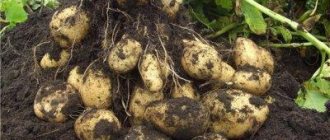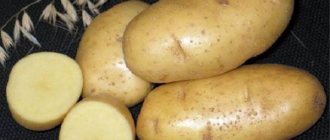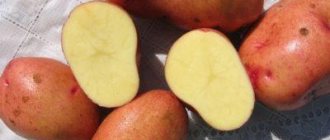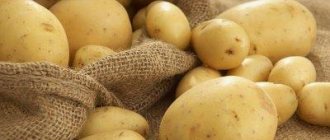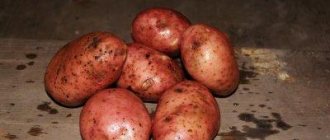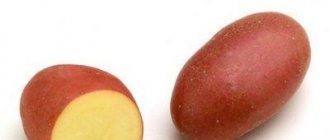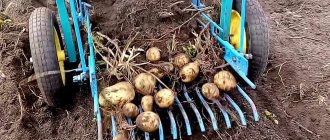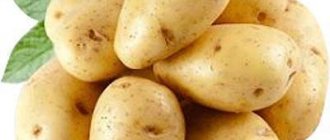Description of the potato variety Rodrigo
| Variety name | Rodrigo |
| general characteristics | mid-early table variety with a large mass of tubers |
| Maturation period | 70-85 days |
| Starch content | 13-15% |
| Weight of marketable tubers | up to 800 gr |
| Number of tubers in a bush | 7-9 pcs |
| Productivity | up to 450 c/ha |
| Consumer qualities | good taste, suitable for pureeing and frying |
| Keeping quality | 95% |
| Peel color | pink |
| Flesh color | yellow |
| Preferred Growing Regions | Volga-Vyatka, North Caucasus, Middle Volga |
| Disease resistance | moderately resistant to all viruses and diseases |
| Features of cultivation | germination recommended |
| Originator | Solana GmbH & Co. KG (Germany) |
Rodrigo potatoes are a mid-early variety, the period from the beginning of germination to the onset of technical maturity (it has optimal root size and durable skin, which means it can be stored for a long time) is approximately 70 - 80 days.
Conditional maturity occurs earlier than technical maturity - the normal size of the potatoes and the lagging thin peel indicate that Rodrigo is ready to eat; you can prepare a lot of delicious dishes from young potatoes.
Some experts believe that root vegetables with peeling skins are not suitable for food, they are not ripe.
Collection and storage of potatoes
After yellowing and drying of the tops, when a dense skin forms on the tubers, harvesting begins. A clear, sunny day is chosen for the event. The dug up potatoes are left in a dark room to dry.
Next, they sort, leaving fruits with mechanical damage for use in the near future. The remaining harvest is divided into planting material and marketable tubers and stored. For these purposes, a wooden box with holes for ventilation is suitable, which is placed on the balcony and insulated. You can dig a hole on the site or store it in a cellar.
Tubers the size of a chicken egg are selected for planting next year. Planting small things leads to degeneration of varietal characteristics. The keeping quality of potatoes of the Rodrigo variety reaches 90%.
Loss of taste and elasticity of tubers occurs 4 months after harvest. Optimal conditions for storing culture:
- humidity not more than 80%;
- storage temperature - 1–4 °C;
- ensuring air circulation;
- lack of light.
If the potatoes are damp but not wrinkled, the tubers are dried and stored again. Green, rotten, wrinkled specimens are not suitable for food. It is not recommended to wash the crop or store it next to other vegetables.
Characteristic
The Rodrigo potato variety has oblong tubers (oval - elongated).
The dimensions promise to be large, no less than the size of a fist, with an average weight of about 200 g. There are tubers up to 800 g, more often up to 500 g under good weather conditions and proper care .
You can compare the weight of tubers and the starch content in them with similar indicators for other varieties using the table:
| Variety name | Starch content (%) | Tuber weight (g) |
| Rodrigo | 13-15 | up to 800 |
| Innovator | up to 15 | 120-150 |
| Riviera | 12-16 | 100-180 |
| Gala | 14-16 | 100-140 |
| Limonka | 8-14 | 75-150 |
| Aladdin | until 21 | 100-185 |
| Beauty | 15-19 | 250-300 |
| Grenada | 10-17 | 80-100 |
| Mozart | 14-17 | 100-140 |
The peel of a mature root vegetable is dense, smooth, and dark red. The eyes are small, located on the surface - without depressions.
Reference. Varieties with superficial eyes, in contrast to tubers with deep eyes, are valued among the population - they are easy to wash, peel, chop and package.
The pulp has a rich yellow color, sometimes creamy. Starch content - from 12.5% to 15.4% - average level. A high level of starch - from 16% indicates good cooking properties; such varieties are suitable for making purees. “Rodrigo” is more suitable for cooking whole tubers, for salads, frying, and soups.
Appearance
The stem bush is semi-erect with several branches, the size is tall. When the potato ripens, the bush disintegrates and turns yellow .
The leaves have a normal shape for potatoes, large sizes, dark green color, wrinkled structure, without pubescence, weak wavy edges. The flowers are large, the corolla is white.
Climate zones
The variety is tested in all regions of the Russian Federation with successful results. The variety is not afraid of heat and drought, and feels great in the northern and southern regions. It is possible to grow in all regions of the country, territories bordering the Russian Federation, and European countries .
Productivity
The yield of this variety is amazing - on average, one bush produces 10 large potatoes. 1 hectare yields 45 tons of potatoes .
95% of the total harvest is marketable. There are practically no small potatoes - all potatoes develop well. The yield at the first digging is high.
Potatoes store well, keeping quality reaches 95 percent. Read about the storage time and temperature and what problems may arise in the articles on our website. And also about storage in winter, on the balcony, in boxes, in the refrigerator, cleaned.
Purpose
Rodrigo potatoes are universal in their method of application.
They are often used as food, also for the production of starch, alcohol components, and other substances. Potatoes contain useful substances (potassium, calcium, vitamin C, B, A, phosphorus, carotene), toxic substances (salonine) in small quantities when properly stored. Carotene, contained in large quantities in yellow potatoes, plays the role of an antioxidant in the body . Salonin accumulates in potatoes over time or exposure to sunlight, so potatoes are stored in a dark place.
Potatoes that have turned green from the light or old, sprouted, wrinkled potatoes should not be consumed - there is nothing useful in them, there is a large amount of salonin. Due to the presence of harmful substances, it is not recommended for pregnant women to consume potatoes.
It has a beneficial effect on the digestive system; it should not be abused in case of gastrointestinal diseases. Potato juice is used for swelling, as a bleaching agent in cosmetology, and as a means to lower blood pressure and regulate blood cholesterol in medicine.
Raw potato juice in large quantities can increase body temperature. People suffering from diabetes should use potatoes with caution - it is better to soak the potatoes for 24 hours to remove starch.
IMPORTANT! It is necessary to cook the tubers immediately after cleaning, this way more vitamins will be preserved.
Taste qualities
They note the excellent taste of “Rodrigo” - an aromatic, delicate consistency with a rich, sweetish taste. Yellow potatoes are considered the most delicious .
IMPORTANT! To preserve all the nutrients, potatoes must be cooked in their skins - boiled or baked.
Country of origin, year of registration
The Rodrigue potato was bred by German breeders and is being successfully tested in the Russian Federation. It is not included in the State Register of the Russian Federation, but there are prerequisites for this.
Advantages and disadvantages
Despite the fact that this variety was brought to us from Germany, gardeners from different regions of Russia have already appreciated its advantages. According to numerous reviews, Rodrigo potatoes have a lot of advantages with absolutely no disadvantages.
- Potatoes are unpretentious to soil composition and can easily tolerate prolonged drought and heat.
- The high yield of the variety is: from a bush - 7-10 fairly large potatoes, from one hundred square meters - up to 600 kg, from one hectare - up to 180-210 tons.
- The varietal characteristics of Rodrigo potatoes are preserved for 5-7 years, providing gardeners with high yields and excellent quality.
- Excellent taste.
- Excellent presentation, which is of great importance for farm owners.
- Transportability.
- Tubers damaged during harvesting and sorting can be safely stored for long-term storage. In places of damage, potatoes do not turn black and do not spoil.
- The variety has very high, genetically determined resistance to many viral and fungal diseases.
- Wide range of applications.
According to the description stated by the originators, potatoes of the Rodrigo variety do not have significant deficiencies. The only drawback is the excessive and premature spreading of the bushes. This circumstance makes it difficult to hill potatoes. However, this drawback can rather be attributed to the advantages of the variety.
The soil under spreading bushes remains moist longer, which means that potatoes will need much less watering.
Interesting! The first harvest of new potatoes of the Rodrigo variety can be tasted in early to mid-July.
Photo
See below: Rodrigo potatoes photo
Preparing the soil and planting site
Rodrigo potatoes (the description of the variety and photos confirm its productivity) develop better in the most illuminated, open areas. The plant also takes root in partial shade, but its yield is significantly reduced, the tubers become smaller, and the risk of developing diseases increases. It is also not suitable for lowlands and areas with close groundwater.
When choosing a location, it is important to follow the rules of crop rotation. So, the best predecessors for potatoes will be cucumbers, cabbage, carrots or onions. You should not plant it after other representatives of the Solanaceae family (tomatoes, peppers, eggplants).
Potatoes take root better and bear fruit on fertile loamy or sandy loam soil. The area for planting should be prepared in advance, in late autumn or early spring.
Instructions:
- Plow the soil to a depth of 35-40 cm.
- Add to each square. m 5-7 kg of compost or humus. Instead of organic matter, you can use superphosphate, adding approximately 30 g per 1 square meter. m.
- Loosen heavy clay soil using sand or rotted sawdust (500 g per 1 sq. m).
Advantages and disadvantages
According to the testing commission, no defects were found, the variety is consistent in quality characteristics.
advantages :
- bountiful harvest;
- large root vegetables of regular shape;
- high percentage of marketability;
- heat and drought resistant;
- not picky about soil type;
- resistant to most diseases;
- resistant to mechanical damage;
- long shelf life;
- high taste qualities;
- universal purpose.
We bring to your attention a table with keeping quality indicators for Rodrigo and other potato varieties:
| Variety name | Keeping quality |
| Rodrigo | 95% |
| Sifra | 94% |
| Queen Anne | 92% |
| League | 93% |
| Milena | 95% |
| Elmundo | 97% |
| Serpanok | 94% |
| Cast iron | 95% |
| Sheri | 91% |
| Bryansk delicacy | 94% |
| Ariel | 94% |
Main positive and negative aspects
Among the shortcomings, gardeners point out one insignificant one - premature lodging of stems, which creates difficulties when hilling the crop. Otherwise, the Rodriguez potato variety consists of the same advantages:
- consistently high productivity;
- presentation of tubers;
- the presence of artificially created immunity that resists diseases characteristic of potatoes;
- unpretentiousness to soil composition and watering;
- preservation of varietal characteristics for up to 7 years;
- high taste and nutritional qualities;
- universal use;
- maintaining a presentable appearance during long-term transportation.
See also
Why do potatoes need green manure, what kind and when is it best to sow?
Read
Gardeners note another amazing property - tubers are preserved in the presence of mechanical damage.
Features of cultivation
Agricultural technology for this variety is standard. The type of soil does not matter, but it is necessary to apply potassium and nitrogen fertilizers.
For more information on how to fertilize potatoes, how and when to fertilize, and how to do this when planting, read the articles on our website.
IMPORTANT! You cannot plant potatoes next to tomatoes or near apple trees. After tomatoes, soil for potatoes should also not be used.
Potatoes like soil that has rested throughout the year, after grains and legumes. Grows well after onions and cabbage.
Potatoes are planted from April to the end of May, the temperature should be within 22 degrees; if the temperature is too hot or cold, the potatoes do not germinate well.
The distance between plants should be at least 20 cm, depth - 10 cm. They are usually planted in furrows, planting “under a shovel” in holes is possible.
When the soil is waterlogged, potatoes are planted on higher ground. “Rodrigo” does not like weed killers; the area should be sprayed with such substances before sprouts appear. To control weeds, it is better to use mulching.
To strengthen the tubers, it is necessary to water the roots with calcium nitrate. Reacts well to loosening, hilling, weeding . During dry summers, no watering is required.
Preparation of planting material and propagation
Potatoes of the Rodrigo variety are propagated using tubers obtained from the previous harvest. They can also be purchased in stores and on online resources dedicated to vegetable growing. You can also get planting material from seeds. This event is not too difficult, but it does take some time.
Growing potatoes from seeds
The plant forms several buds, from which fruits - berries - are eventually formed.
And in order to collect seeds from them and grow potato seedlings, you will need to follow these instructions:
- At the end of July - beginning of August, when the above-ground part of the plant has died down, collect the berries and lay them out on newspaper on a light and warm windowsill.
- When the fruits ripen, around mid-November - early December, they will soften, lighten and acquire a pleasant aroma. At this time, cut them and remove the pulp and seeds.
- Grind the mixture on a thin cotton cloth and wash under low pressure of water to remove any remaining pulp. It is important that the seeds come into contact with moisture for no longer than 5 minutes.
- Place the washed grains on paper in a cool, dry place. When they are completely dry, place them in a paper bag and store them in a dry cupboard.
You should start sowing potatoes in mid-late March. For the event, you will need to prepare a planting container with a height of up to 5 cm and drainage holes. It is also necessary to purchase special soil intended for growing vegetable seedlings.
You can make the substrate yourself by combining garden soil with peat (1 to 4). The resulting mixture will need to be sterilized by heating in the oven for 30-45 minutes at a temperature of +90 °C. When the soil has cooled, add 1-2 tbsp. l. fine vermiculite, and spill with Fitosporin solution, leave for 24 hours.
30 minutes before sowing, cover the saucer with a cotton napkin. Distribute potato seeds evenly over its surface and pour Fitosporin-M solution over them.
You need to sow seeds according to the following algorithm:
- Fill the container with nutritious soil, not reaching the edge by 1.5-2 cm.
- Level the soil surface and water generously with warm water from a spray bottle.
- Draw shallow grooves with a pencil, keeping a distance of 5 cm between them.
- Using a toothpick, distribute the seeds into the indentations. It is advisable to maintain a distance of 5 mm between them. Do not sprinkle the planting material with soil or water it, otherwise it will not sprout.
- Cover the planting with glass or transparent film and place it in a warm place, with diffused lighting and without drafts.
Until the seedlings emerge, you will need to ventilate the greenhouse daily, opening the lid for 10-15 minutes. Condensation should be removed from the walls as it appears.
The first seedlings will sprout 6-12 days after sowing. Further care of the seedlings consists of regular but moderate watering. Moreover, pour water through a watering can or spray bottle, because drops of moisture immediately rot the stems and leaves. To avoid this, you need to use the bottom watering method. To do this, the seedling container must be placed in a basin filled with warm and settled water for 15-20 minutes.
It is important to provide the seedlings with 12-15 hours of daylight. To do this, it is better to install phytolamps near the container and turn them on in cloudy weather, in the morning and evening.
If some seedling is rotten, then it must be removed along with 2-3 neighboring seedlings and a lump of earth. To prevent infection of healthy specimens, the vacated space must be poured with a solution of potassium permanganate through a pipette.
You can plant seedlings in open ground from the second half of May.
During the process you will need to follow these instructions:
- Dig holes with dimensions of 15*15 cm. Maintain a distance of 35-40 cm between the depressions, the interval between rows is 70-80 cm.
- Add 200 ml of humus, 1 tbsp. l. ash, 0.5 tsp. ground eggshells. Mix the fertilizers thoroughly with the soil.
- Place the seedlings one at a time into the recesses, placing them at an angle of 35-45°. Gradually fill the voids with soil.
- Water the planting generously with warm water.
It is advisable to mulch the soil surface with straw or peat. It is also worth covering the planting with spunbond or regular film to prevent the seedlings from freezing. You can remove the cover when the plants take root in the new place. After 2-3 weeks, the senza needs to be fed with mullein infusion. During flowering in the soil, it is worth feeding the crops with potassium sulfate.
Potatoes grown from seedlings should be harvested at the usual time. But the tubers will be small, and it is better to use them for planting next year. Then the harvest will be maximum. And it is worth updating planting material through seedlings every 5-6 years to prevent potato degeneration.
Sprouting potatoes before planting
Tubers should be prepared 3-4 weeks before planting.
To do this you will need to follow these instructions:
- Transfer the potatoes to a bright place with a temperature of +14...+16 °C, and spread them in one layer on a flat surface.
- Sprinkle the tubers daily with warm water, and regularly remove rotten and softened specimens.
- On the day of planting, dip each potato in a solution of the “Fitosporin” fungicide, being careful not to damage the sprouted eyes.
Additionally, you can soak the planting material in a solution of growth stimulants (Epin, Zircon) for 2-3 hours. This will improve the survival rate of tubers in the garden, and accordingly, accelerate the ripening of the crop, and increase its quality and quantity.
If there is not much planting material, then you can cut the tubers into several parts. But each of them should have 2-3 sprouts. It is important to act extremely carefully so that the sprouts do not break off. The tubers should be divided with a sharp, sterilized knife. It will need to be treated with a dark solution of potassium permanganate after each cut.
The event must be carried out 2-3 days before planting the tubers in the garden. Then the cut areas will have time to dry, which will reduce the risk of rotting. During planting, it is important to sprinkle the cuttings with crushed chalk or wood ash. And before and after the procedure, the garden bed cannot be watered.
Diseases and pests
Very resistant to tuber cancer, nematode, scab, and late blight. It is necessary to carry out preventive spraying with special preparations against pests. Special chemicals will help in the fight against the Colorado potato beetle: Aktara, Corado, Regent, Commander, Prestige, Lightning, Tanrek, Apache, Taboo
As mentioned above, the main damage to potatoes is caused by the Colorado potato beetle. Read all about folk remedies and chemicals for insect control in our articles.
We also bring to your attention useful information about the most common potato diseases: Alternaria, Fusarium, Verticillium and late blight.
Care
Potatoes of the Rodrigo variety, the photo of which is given in the material, belong to unpretentious crops. And according to the description, in order to get a good harvest of tubers, it is enough to provide the plant with minimal care, consisting of infrequent watering, periodic fertilizing, loosening and weeding.
Spraying and watering
Potatoes of the Rodrigo variety are drought-resistant and only need to be watered during particularly dry periods. So, the first irrigation should be carried out when the bushes reach a height of 10-12 cm. About 4-5 liters of water will need to be poured under each plant.
It is advisable to water the crop again during flowering. Moreover, during this period it is worth irrigating once every 5-7 days. In the future, it is enough to water the garden bed 3 times a month.
It is better to irrigate potatoes using the sprinkling method. And the procedure itself should be carried out in the evening, after sunset. Otherwise, the moisture will quickly evaporate under the sun, and the leaves will get burned. 10-12 days before harvest, watering should be completely canceled.
Top dressing
To increase productivity, it is better to fertilize Rodrigo potatoes according to the following scheme:
- When the plants reach 13-15 cm in height, add nitrogen fertilizer. You can use a liquid solution of ammonium nitrate (10 g per 10 l), using per square meter. m of planting 4-5 liters of fertilizer. From organic matter, a solution of chicken manure, green fertilizer or mullein infusion is suitable.
- 2 weeks before flowering, add liquid formulations with humic acids. Special preparations “Fasko potato”, “Kemira for potatoes”, “Energen Aqua” are suitable. Dilute fertilizers according to the instructions and spray them on the above-ground parts of the plants.
- After flowering is complete, feed the potatoes with a solution of fermented chicken droppings or slurry.
Fertilizers should be applied in the evening, after sunset. And before the event, you need to water the plants well, otherwise they will get burned from fertilizing.
Trimming
Rodrigo potatoes (the description of the variety and photos confirm the large size of the tubers) do not need pruning. But it is better to immediately remove the above-ground part of the plant as soon as it dries, leaving stumps 10-15 cm high. This will prevent infection of the tubers by pests.
Loosening and weeding
After rain or watering, a dense crust forms on the soil surface. It prevents air from reaching the roots, which slows down the formation of tubers. And to improve soil aeration, it is important to loosen it regularly. But directly under the bushes this should be done carefully so as not to damage the stems and lateral roots of the plant.
A potato bed needs to be weeded regularly, as weeds draw nutrients from the soil, taking them away from the potatoes. They are also the main sources of diseases and pests. The first time weeding should be done when the plants reach a height of 4 cm. In the future, it is enough to combine the activity with loosening.
Hilling
Hilling is an important agrotechnical technique necessary for potatoes. Thanks to the event, the growth of lateral roots is activated, which contributes to the growth of tubers and improves their taste.
And you need to hill up the bushes several times a season:
- When the tops reach a height of 12-15 cm, sprinkle the stem with a mound of earth 3-4 cm thick.
- With a stem height of 20-22 cm, hill up 2/3 of the length of the bush.
- Repeat the event after 2 weeks. Increase the hill of earth by another 5-6 cm.
Hilling up should be combined with weeding and loosening. But it’s better to start activities in the evening, especially if the weather is hot. Otherwise, the stems and young tubers will get burned from the hot earth.
Optimal conditions
Potatoes of the Rodrigo variety develop and form tubers at temperatures above +15…+16 °C. The crop tolerates short-term cooling, but may die during frost. The plant is drought-resistant and easily tolerates hot weather. But high humidity is detrimental to it, because of which the tubers and the above-ground part of the crop rot. And during a rainy summer you can lose most of the harvest.
About the taste of “Rodrigo”
The variety has excellent nutritional qualities. Today, in pursuit of weight, yield, and disease resistance, breeders often sacrifice nutritional and taste characteristics. The new product of German selection stands out against this background - pink tubers are excellent in any form:
- boiled - do not boil;
- puree – soft, airy, thanks to the high starch content;
- fried – does not fall apart when fried, holds its shape well.
Advice from experienced gardeners and reviews about the Rodriga variety
Gardeners mostly leave positive reviews about the Rodrigue potato variety.
Larisa, Balashikha: “For the first time I grew the Rodrigue potato variety, or, as we called it, Rodriguez. When planting, the tubers had to be cut into 3 parts. They were grown like other varieties, only they were dug up earlier. All the tubers turned out about the same, the taste is excellent!”
Alexander, Tver: “Our family really loves the Rodrigo potato variety. Of course, you have to fight the Colorado potato beetle, but the rich harvest is worth it! Our secret is that we germinate tubers in plastic bags.”
Valentin, Belgorod: “This undemanding variety survived the hot summer perfectly, the harvest appeared in 70 days, and this is on not very rich soil! It stores well, even if the tubers are damaged by a shovel.”
Newfangled ideas: truth and fiction
Recently, various “innovative” ideas on the topic of growing potatoes, including very dubious and controversial ones, have been widely promoted on the Internet.
Growing potatoes from seeds
From the “light hand” of seed producers, a belief began that potatoes supposedly require periodic “renewal” and “health” by growing from botanical seeds. In fact, seed propagation of potatoes is advisable in exactly two cases:
- in breeding work when developing new varieties;
- in companies specialized in growing planting material for accelerated propagation of breeding novelties.
Stable zoned potato varieties, which include Rodrigo, retain varietal characteristics well during vegetative propagation by tubers and do not require reseeding. With regular crop rotation and proper selection of planting material, no “degeneration” of potatoes occurs. Moreover, seed propagation has a number of very significant disadvantages:
- This method is very labor-intensive and requires growing seedlings with picking and transplanting, covering with film and more careful care.
- With the seed growing method, the plants inevitably turn out less uniform than when planting tubers. When collecting seeds yourself, it is generally impossible to maintain the purity of the variety due to cross-pollination with other varieties growing in the neighborhood.
- It is impossible to immediately obtain a commercial harvest from seeds. In the year of sowing, only mini-tubers grow, the so-called sets, which are not so easy to preserve until next spring.
- When purchasing tubers, you can immediately be more or less reliably convinced that they correspond to the variety in shape and color. Buying seeds is always a “pig in a poke.”
Poisonous potato berries contain seeds that are used only to create new varieties
Growing potatoes under straw
Another actively promoted fashionable idea is growing potatoes under a layer of straw or hay, supposedly allowing “no digging, no hilling, just harvesting.” There really is some truth in this. Initially, this method appeared in the century before last in the conditions of the North and North-West of Russia, where summers are cool and rainy, and the soils are dominated by light sandy loam and peaty soils. It is only under these conditions that growing potatoes under straw can give good results. The tubers are laid out on the surface of the soil and covered with a thick layer of straw or hay (about 20 centimeters thick). Under constant rain, the bottom layer of straw immediately begins to rot, creating a favorable environment for the development of potato roots and supplying them with nutrients. However, this method also has its disadvantages:
- It is strictly forbidden to use straw near buildings in fire hazardous areas with hot, dry summers. Dry straw flares up like gunpowder at the slightest spark.
- On heavy clay soils, it may happen that the roots do not have enough nutrition. Weak potato roots easily penetrate from the surface only into light, loose soil. By covering heavy clay with straw in a dry summer, you run the risk of harvesting potatoes the size of peas in the fall.
- Potato tubers not covered with soil under a layer of straw become tasty prey for mice, voles, woodlice, snails and slugs. During normal planting in the soil, all these pests do not touch the potatoes. But sooner or later the Colorado potato beetle will appear from the neighbors; these beetles easily fly for many kilometers around.
- The most difficult to eradicate rhizomatous weeds (sow thistle, bindweed, cowgrass, wheatgrass, etc.) easily germinate through straw.
- Straw of unknown origin may be treated with pesticides, including herbicides, that can kill potato sprouts.
Growing potatoes under straw is only permissible in regions with rainy summers
How to properly care for the variety
Tubers begin to set even before flowering, which requires sufficient soil moisture. The process of growth and formation of root crops slows down when hot, dry weather sets in, and in the absence of watering it can lead to a poor harvest. To avoid this, it is necessary to water the potato plantings at least once a week to a depth of 20 cm.
Attention! Sprinkling is allowed only at the beginning of the growing season in areas not affected by late blight.
The period of growth of root crops in this variety must be accompanied by the application of fertilizing. Three times a season, the soil in the area where Rodrigo’s potatoes are planted is fertilized with organic and mineral fertilizers:
- At the moment of active formation of the bush.
- At the very beginning of flower formation.
- During flowering.
To protect varietal potatoes from the spread of diseases, it is necessary to regularly weed the beds with bushes. When the height of the plants reaches 20 cm, hilling can be carried out simultaneously with weeding, which will retain moisture in the soil and create favorable conditions for the formation of root crops.
To ensure the formation of a bountiful harvest, plants also need deep loosening. It is advisable to carry out the procedure after precipitation, but if the soil is too heavy, this should be done regularly, without waiting for rain.
History of the appearance of the variety
Rodrigo is a super successful variety of German origin (in catalogs this variety is often presented as “Rodrigue”). The author of the variety is (Germany). The variety, despite its European roots, quickly took root in Russia.
Its cultivation is especially profitable in the Middle Volga region - here, due to the successful combination of soil and climatic conditions, the crop achieves maximum yield. However, the glory of “Rodrigo” is not limited to the Volga region; gardeners from different parts of Russia successfully grow German potatoes, enjoying the harvest.
Planting potatoes
Tubers the size of a chicken egg are considered ideal planting material.
Pre-germination
To obtain an early harvest, the tubers are germinated in the light. Germination begins about a month before the intended planting. The tubers are laid out in one layer in a bright room with a temperature of about +15°C. During germination, the tubers become covered with thick, dark green sprouts. To make potatoes wrinkle less, spray the tubers with water from a spray bottle once or twice a week. Sick, rotten tubers are immediately thrown away.
When properly germinated in the light, potatoes produce short green sprouts
The white elongated sprouts formed in the dark are poorly viable and easily break off, so light is very important during germination.
If larger tubers are used for planting, to save money you can cut them into several parts, each of which should have several sprouts. It is most convenient to do this at the beginning of germination, when the eyes are already awake, but the sprouts are still small. After each tuber, the knife is disinfected with alcohol or a solution of potassium permanganate. The sections are sprinkled with wood ash. Cutting the tubers is carried out no later than a week before planting, so that the sections have time to become covered with a protective crust. This method is not used in waterlogged areas due to the increased risk of rotting of cut tubers.
To save money, large tubers for planting can be cut into pieces
Site selection, fertilizers and crop rotation
Potatoes grow best on light sandy and loamy soils with an acidity of 5.5 to 7. The area should be well lit by the sun and, if possible, be free from the rhizomes of perennial weeds. In the spring, when digging, add half a bucket of humus and a glass of wood ash per square meter. Approximate rate of mineral fertilizers: 30–40 g of superphosphate, 15–20 g of ammonium nitrate and 10–15 g of potassium chloride per 1 square meter. Fertilizers are spread evenly over the entire area of the site before digging.
Fresh manure cannot be used when planting potatoes.
It is very harmful to grow potatoes in the same place for more than 2-3 years in a row, this depletes the soil and contributes to the accumulation of infection. The best predecessors are pumpkin, cabbage and especially legumes. You cannot plant potatoes after other nightshades (tomatoes, peppers, eggplants) or before them; they have many common pests and diseases.
Planting scheme
Traditionally, potatoes are planted in rows for ease of care.
Potatoes are planted in rows “under the cord”
- In a previously dug area, using two pegs and a cord, mark rows at a distance of 70 centimeters from each other.
- “Under the cord” they dig grooves 10–15 centimeters deep.
- Sprouted potatoes are placed in the grooves at a distance of about 30 centimeters from one another. Place the cut potatoes cut side down, sprouts up.
- The grooves are carefully covered with earth. As a result, there should be a layer of soil above the tubers from 5–6 centimeters on heavy clay soils to 10–12 centimeters on light sandy soils.
